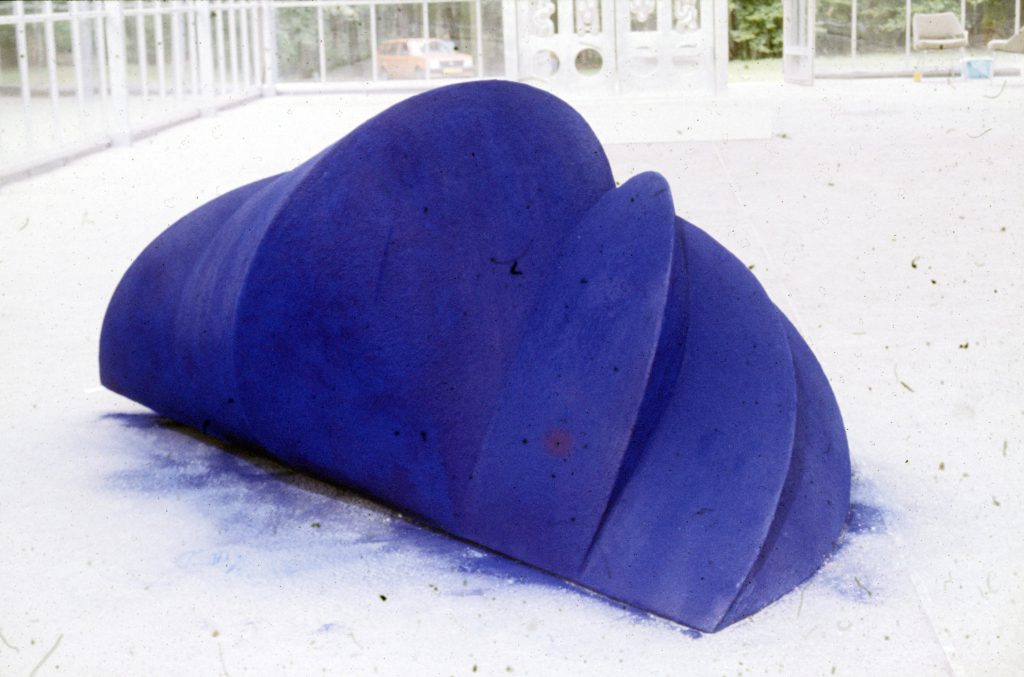Anish Kapoor, Pot for her, 1985

Anish Kapoor, Pot for her, 1985, pigment en gemengde techniek, 169 x 104 x 104 cm. Fotograaf Gemeentearchief Arnhem (CC0 1.0 licentie)
In 1979 reist Anish Kapoor (1954) na een zevenjarige studie in London terug naar zijn geboorteland India. Deze reis leidt tot de serie pigmentsculpturen 1000 Names (1979-1980), waarmee hij in Engeland voor het eerst bekendheid krijgt.[1] In de jaren tachtig en negentig blijft Kapoor experimenteren met pigmentsculpturen in allerlei vormen, maten en kleuren. Deze werken, waaronder Pot for Her (1985), bestaan veelal uit hout of gips met een monochrome laag pigmentpoeder. Vanwege het kwetsbare materiaal kan Pot for Her alleen in een van de paviljoenen worden getoond. Het illustreert Saskia Bos’ karakterisering van hedendaagse beelden als “kunstmatige produkten die zich niet aan de natuur aanpassen.”[2]
Wat opvalt aan Pot for Her is de ovaalvormige opening aan de voorzijde. Hierdoor is de beschouwer geneigd om in de sculptuur te kijken, maar het is niet mogelijk om te zien hoe de donkere holte er precies uitziet. De ovaalvorm, die ook voorkomt in een aantal latere sculpturen en tekeningen van Kapoor, mag beschouwd worden als representatie van het vrouwelijke geslacht. Kapoor wil echter geen erotisch werk maken. Hij vertelt in een interview in 1989 dat zijn interesse in seksualiteit betrekking heeft op het thema oorsprong.[3] Voor Kapoor is dit een fundamenteel gegeven voor alles om ons heen. Pot for Her lijkt gezien de titel (“pot voor haar”) metaforisch voor de oorsprong van de mens in de baarmoeder.
Het concept oorsprong wordt gesymboliseerd door de donkere holte. Kapoor legt uit: “It’s a space of becoming… ‘something’ that dwells in the presence of the work…”[4] De ‘ruimte van wording’ belichaamt volgens Kapoor ook angst. Als de beschouwer zichzelf indenkt dat hij of zij is opgesloten in deze ruimte, dan bekruipt het gevoel dat we onszelf verliezen.[5] Uiteindelijk is Pot for Her eerder een lust voor het oog in plaats van griezelig. Dankzij de vorm en de ultramarijn blauwe kleur krijgt het werk een poëtische of spirituele gevoelswaarde. Dit wordt versterkt door het oppervlak dat bestaat uit pigmentpoeder.
[1] L. Cooke, “Mnemic Migrations”, in: Homi K. Bhabha (red.), ten. cat. Londen (Royal Academy), Londen 2009, p. 163.
[2] S. Bos, “Contouren van Sculptuur”, ten. cat. Arnhem (Sonsbeek 86: internationale beeldententoonstelling), Utrecht 1986, p. 14.
[3] A. Meer en A. Kapoor, “Anish Kapoor by Ameena Meer”, in: BOMB, Vol. 30 (winter 1990).
[4] C. van Winkel, “On the sublime in the work of Anish Kapoor”, in: Homi K. Bhabha (red.), ten. cat. Londen (Royal Academy), Londen 2009, p. 168.
[5] Ibidem.
